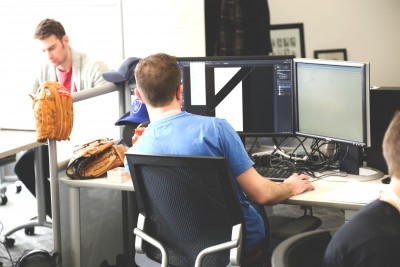Whether good news or bad news, we’ve all heard everyone talking about millennials. There’s really no way to avoid them since there are 80 million in the U.S. and more entering the workforce day after day — almost 50% of millennials plan to actively look for a new job in 2015, according to a study by Aon Hewitt.
So in order to attract and keep this generation engaged, you’ll have to start listening to their needs. Gartner, a global research firm, found these interesting stats:
- Employees are only spending about 40% of time at their personal workstations
- Non-group tasks have decreased to about 20% of the working day
The dynamic of the work environment is changing, and can you guess who’s behind that? You guess it: millennials. As a generation that grew up collaborating, this crowd expects that in the workplace. So if you really want to attract millennials and tap into this pool of talent, you’ll need to consider restructuring or redesigning your workplace setup. Doing this will help create an environment that fosters collaboration and creative thinking — both of which this generation highly values.
Fall of the Wall

In a typical workplace, employees would withdraw to their own private space. The human silo. Millennials don’t want this. They crave collaboration. And the first step to satisfying their hunger for teamwork is to say “rest in peace” to those cubicles. In fact, companies that moved from cubicles to an open-floor plan enjoyed some amazing results, according to this study by interior design and research firm Knoll:
- Performance increased by an average of 440%
- There was a 5.5% reduction in business process time and cost
This makes sense. Walls are a physical obstacle that blocks communication. They separate people and prevent them from talking to each other. So is there any good reason for organizations to still keep them up? Try grouping desks together in pods or lining them up in rows so employees are in close contact with each other. And make sure teammates can easily talk to one another without having to shout or move too far from their desks.
Space for Collaboration
After the walls are gone, the next step is to give millennials the space they need for collaboration. According to this survey by IdeaPaint, millennials reported that only 30.8% of their ideation meetings are planned. So to support that process, here are solutions that encourage both spontaneous and scheduled brainstorming:
- Open meeting areas: Scatter tables and chairs in various nooks and crannies around the office. This allows employees do some spur-of-the-moment teamwork instead of making them wait until they can schedule a meeting room. Even better, hang up a whiteboard nearby, and you’ve got a truly productive space.
- Break rooms: Opposite to what you may think, idle chitchat around the water cooler isn’t always time wasting. Employees tend to create conversations that are work related, so you never really know when a brilliant idea will pop up.
- Meeting rooms: Besides spontaneous gathering areas, don’t forget to keep rooms that people can schedule. This is ideal for when there’s a sensitive topic on the horizon or you need to gather a large party.

Collaboration can’t always be done at people’s desks — especially if it involves three or more people. So to encourage this type of work, you’ll need to designate specific spaces so people can be free to unleash their creative ideas with one another.
Space for Privacy
The one thing to keep in mind is that we’re not saying to get rid of all privacy. Collaborative areas are extremely important, but so are private spaces. This comes in handy when an employee needs to work on a complex project or a task that involves fine attention to details. With these spaces, they’ll be able to really hone in on their task and keep focus. And the walls don’t have to be fully enclosed; partitions will suffice. Just having that minor barrier still allows employees to zone in on their task. An office that pairs collaborative and private spaces gives employees the flexibility to choose workstations that suit whatever task they’re working on. It’s always said that millennials are shaking up the workplace in a negative manner. However, that’s not the case. They’re actually making it better for employees of all generations. So to really attract them to your organization and keep them truly engaged, you’ll need to create an environment that fosters their collaborative nature.
 David Niu is the Founder and CEO of TINYpulse, an employee engagement survey solution that empowers leaders with actionable feedback to make positive changes in their workplaces. David is a serial entrepreneur, having founded and successfully sold two prior businesses, NetConversions and BuddyTV. He attended the University of California at Berkeley for his BA and the Wharton School at the University of Pennsylvania for his MBA. He was named a “40 Under 40” recipient by the Puget Sound Business Journal and is actively involved in the Entrepreneurs Organization “EO.” David is also the author of Careercation: Trading Briefcase for Suitcase to Find Entrepreneurial Happiness.
David Niu is the Founder and CEO of TINYpulse, an employee engagement survey solution that empowers leaders with actionable feedback to make positive changes in their workplaces. David is a serial entrepreneur, having founded and successfully sold two prior businesses, NetConversions and BuddyTV. He attended the University of California at Berkeley for his BA and the Wharton School at the University of Pennsylvania for his MBA. He was named a “40 Under 40” recipient by the Puget Sound Business Journal and is actively involved in the Entrepreneurs Organization “EO.” David is also the author of Careercation: Trading Briefcase for Suitcase to Find Entrepreneurial Happiness.